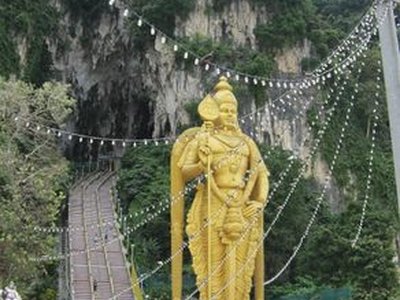Batu Caves


During Thaipusam, an annual celebration
of the triumph of good over evil, hundreds of thousands of spiritual pilgrims climb the 272 stairs up into the Batu Caves carrying kavadis, symbolic burdens which include elaborate body piercings.
This is the Malaysian version of a Hindu festival celebrated among the Tamil community in countries such as India, Sri Lanka, Singapore, Indonesia, Thailand, and Myanmar.
Thaipusam comes from the junction of two words, the Tamil month called “Thai” and a star, named “Pusam.”
Observed each year in January or February according to the Tamil calendar, the festival of Thaipusam honors the Hindu god Murugam and his victory over the demon Surapadman with his vel, or lance. Festivalgoers wearing yellow or orange observe traditions including shaving of the head, and carry kavadis representing the fulfillment of vows to Murugam, thanking him for favors done or in advance for future favors sought.
The most common kavadis are fruit, flowers, or a pail of milk, but others are as elaborate as heavy peacock-feather covered shrines carried on the head, representing the defeated demon who was transformed into a peacock. The most famous images of the festival are of devotees with cheeks and tongues pierced with ceremonial lances, and others hauling large kavadis with hooks in their backs. The piercings, along with fasting and ritual, induce a trance-like state intended to focus thoughts inward. At the caves a swami removes the piercings, lifting the spiritual burden.
Located seven miles north of Kuala Lumpur, the caves were made famous in 1878 by zoologist William Temple Hornaday. While Malaysia was still a British colony, the caves were also a popular site for picnicking British couples. The stairs were added in more recent times.
The gallery of the main Temple Cave at the top of the stairs is 300 feet high and 1200 feet long, with small openings letting in natural light. A smaller gallery is up another fight of stairs, mostly open to the sky. Two other smaller caves are also at the site.
In 2006, a 140-foot tall concrete statue of Murugan was added at the foot of the stairs in the weeks preceding Thaipusam, a giant chrysanthemum garland draped around his shoulders by construction crane.
The caves are home to colonies of long tailed-macaque monkeys which roam the stairs and the caves, and have been known to swipe sunglasses, cameras, and snacks from tourists.
In 2009, more than a million people visited the caves during Thaipusam.